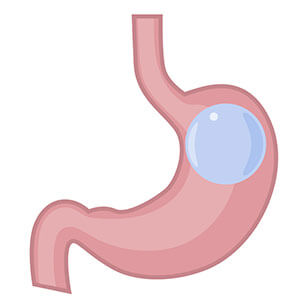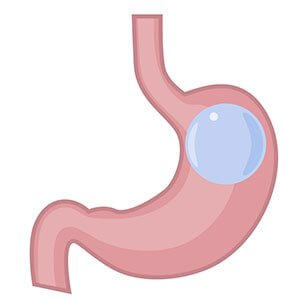
Surgery Duration
30-60
Minutes

Anaesthesia
Sedation

Hospital Stay
1 Night

Total Stay in Turkey
2 Nights
We’ll get back to you within one business day (via e-mail & WhatsApp)
Intragastric balloon placement, otherwise known as gastric balloon surgery, is a weight-loss procedure that involves placing a saline-filled silicone balloon into your stomach. This helps you to lose weight by limiting how much you can eat as well as making you feel fuller much faster than before. If you are someone concerned about your weight, and diet with exercise hasn’t worked for you, our gastric balloon Turkey surgery may be an option here at Badge Clinic.
Similar to other weight-loss procedures such as sleeve gastrectomy surgery, a gastric balloon procedure requires your full commitment to a healthier lifestyle. You will need to make permanent healthy changes to your diet and lifestyle, including regular exercise in order to maintain the long-term success of the procedure.
If you are interested in finding out more and booking your free consultation, please complete our online enquiry form. We’ll be in contact as soon as possible to discuss treatment options, including other cosmetic surgery Turkey procedures you may be suitable for.




Gastric balloon surgery is a minimally invasive weight loss procedure that helps patients who have struggled with losing weight to achieve significant and sustainable weight loss. It involves placing a soft, expandable balloon into the stomach through an endoscopic procedure. Once inserted, the balloon is filled with a saline solution, partially filling the stomach and creating a feeling of fullness. The idea of this is to reduce hunger and limit food intake, leading to a reduction in calorie consumption that will help to lose weight and then sustain this.
Rather than being permanent, the gastric balloon remains in place for a specific period which is typically six months. After this time, it is then removed. A gastric balloon in Turkey is suitable for you if you have struggled with weight loss through other methods, such as a low-calorie diet and exercise, and are looking for a solution to help you reach your target weight. We understand losing weight and maintaining this can be difficult, so gastric balloon surgery can kick-start weight loss efforts and provide a solution for long-term lifestyle changes. Our expert team at Badge Clinic is dedicated to guiding and supporting patients through their weight loss journey, ensuring optimal results and improved overall health, so we can arrange a consultation to see what your bespoke treatment plan will look like.
Many people choose to have this type of procedure performed abroad due to the savings in cost when compared to at home. When you compare the gastric balloon cost in Turkey to the UK, you’ll see you can make significant savings whilst still having the treatment performed by leading surgeons within world-class medical facilities. At Badge Clinic, patient care is extremely important, and we are proud to be renowned for many types of cosmetic procedures including those around weight loss such as gastric bypass Turkey surgery.
Medical tourism is thriving in Turkey thanks to lower procedure costs through subsidised treatment, and our standard packages include not only the gastric balloon cost in Turkey but also 5-star hotel accommodation and VIP transfers to help you get to the hospital, hotel and airport. We want you to enjoy your stay in Istanbul whilst benefiting from expert treatment and patient care. All surgery is performed inside internationally certified hospitals by fully qualified and experienced medical professionals.




Gastric balloon surgery is the ideal procedure to assist your weight loss efforts and improve your overall health and well-being. It is designed to assist with weight loss in people who have 10 to 30 kilograms of weight to lose, with a minimum BMI of 27.
It can also be considered for those who are not suitable for other forms of weight loss surgery. The use of the gastric balloon may assist in reducing weight before surgery, therefore reducing the risks associated with surgical procedures on overweight patients.
If you want to find out more and explore your weight loss options and feel a gastric balloon in Turkey would be beneficial for you, please contact us. We’ll be happy to arrange a free consultation and see what we can do for you at Badge Clinic, helping to start you on your journey to a healthier weight and body confidence.
There may be some discomfort during the first few days after the gastric balloon in Turkey surgery, which is common, however, this should dissipate if you follow the portion size recommendations provided by your doctor and dietitian. You may be able to feel the balloon when you palpate (gently press down) your stomach, but otherwise, you will quickly get used to having a gastric balloon fitted.
You will be provided with specific dietary advice from our expert team of dietitians. Around the time of insertion, adjustment or removal, your diet will be restricted, however outside of these periods, you are able to enjoy most foods without concern.
Some foods may cause symptoms, such as spicy, rich/ fatty or tough foods which don’t break down easily. Red meat and especially steak may cause indigestion. Fish and chicken are generally fine. Fibrous vegetables should be cooked until soft.
The Orbera gastric balloon is placed in the stomach for 6 months, while the Spatz3 adjustable gastric balloon is placed in the stomach for 12 months. Should your doctor recommend the use of the gastric balloon for a longer period, the balloon must be replaced with a new one at the six or 12 month interval.
The gastric balloon is removed in the same way it was placed, via the oesophagus and mouth using an endoscopic camera. Your doctor introduces a catheter (tube) through the mouth and into the stomach, attaching it to the balloon for deflation. Once the balloon is deflated it can be grasped and removed through the oesophagus and mouth.